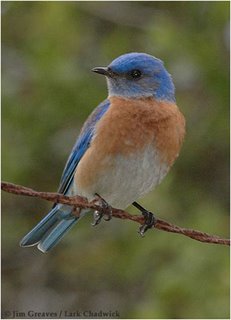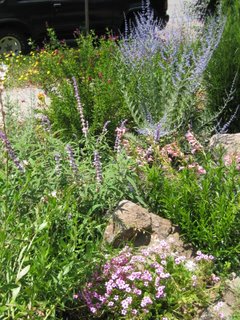The following originally appeared in Chesapeake: The Sierra Club Maryland Chapter Newsletter Online and answers some of the questions I face every year at this time.O Tannenbaum: The Good, the Bad, and the Alternativesby Annie Rehill | December 2005
Don’t fret about harming nature with your choice of a real Christmas tree, trade associations assure us. Christmas tree farms are good for the environment. They “improve the air we breathe, the water we drink and the sights and sounds of the world around us,” claim the Christmas Tree Farmers of Ontario, chiming in with many others. “They help to control the effects of climatic conditions and provide a habitat for a variety of birds and small animals.”1
In Maryland, Jarrettsville Nurseries, “specialists in Christmas trees since 1961,” features an environmental impact statement on its web site that states cheerfully: “The majority of Christmas tree growers have developed evergreen forests from what was once land planted in corn, wheat, hay, etc. Through these Christmas tree plantations, soil erosion has been substantially reduced and a habitat for wild life has been developed.”2
Very reassuring. Plus they suck in carbon.
A quick internet search yields 20 Christmas tree associations across the northern United States and in Canada, even in Ireland. Naturally, they are biased. But even environmental organizations don’t deny the benefits. “Purchase a tree from a tree farm rather than cutting one down in the wild,” urges the National Wildlife Federation. “For something a little different, use a living tree in your yard and decorate it with edible ornaments for birds and other wildlife.”3 (Of course it will get a tad chilly out there during your holiday nights—bonfire?)
“We opt for a real tree,” agrees the Green Challenge, “a part of the holidays since the first decorated Christmas tree appeared in Riga, Latvia, in 1510. Nowadays trees cut for Christmas are grown on farms, often on land unsuitable for other crops.”4
What’s more, the Ontario farmers observe: “Christmas trees often occupy corners and odd parcels of land which might otherwise lie fallow and be subject to erosion. . .Real Christmas trees are a natural, biodegradable, non-polluting and environmentally friendly product.”
Okay then, over the fields to the Christmas tree farm we go.
The Bad Hold it, not so fast: In 2002, Sierra Club member Dashka Slater wrote: “The big downside is the more than 40 different pesticides used in tree farming, including nasty ones like the herbicide atrazine, a hormone disrupter linked to prostate cancer.”5 Methyl bromide has since been phased out for widespread use, but insect eradication remains common practice.
Yikes! What to do? Saw off a few branches and hang ornaments on those? I’ve seen this done beautifully in a friend’s home, with fir limbs suspended from the wall and twinkling with festivity.
Or go the fake route? In her 2002 article, Slater continued: “If you use the same [plastic tree] each year, you’re only tapping our petroleum supply once, not burning up gas on every trip to the tree lot. (They’re pesticide-free, too.) For a natural look, try making your own tree of trimmed evergreen boughs, a storm-felled branch, or a piece of driftwood.”
All very pretty perhaps, but, as the National Christmas Tree Association points out: “Artificial trees are a petroleum-based product manufactured in mostly Chinese factories. A burden to the environment, artificial trees aren’t biodegradable and will remain in landfills for centuries after disposal. The average number of years people use an artificial tree before throwing it away is only six to nine years.”6
Oh dear, must we give up Christmas trees altogether?
The Alternatives Maybe not. First of all, if you can locate one, a few farms advertise organic trees. I found one in southern New York, Blooming Hill Organic Farm (845-782-7310). In Maryland I found none—but with a little patience, you may have more success. To pursue the question, start with Maryland’s Cooperative Extension Program Department at www.marylandagriculture.com. If you don’t find anything through the links there, the next step is to call the organization and ask.
Even if you discover that Maryland Christmas tree farmers are not going the organic route, you may opt to go ahead and buy from them anyway. Pesticide use does not automatically mean the groundwater is being poisoned, or that the toxins remain permanently in the tree’s bark or leaves.
University agricultural extension agents promote integrated pest management (IPM), the responsible, targeted application of minimal effective pesticide doses on an as-needed basis only. Farmers who choose IPM—and increasing numbers do—may not be able to advertise organically grown trees, but their use of toxic substances has declined to the point that they often do not penetrate the soil. By the time your tree is cut down, the minimal pesticide has degraded and you could practically eat the tree yourself without harmful effects. (For more on the University of Maryland’s IPM Program, see www.mdipm.umd.edu.)
Farmers’ IPM choice is often motivated by money. Most synthetic pesticides are made from oil, and prices are rising. Like other farmers, those growing Christmas trees don’t have a lot of room to make a profit. Thus they are turning to IPM, or at least to more judicious pesticide applications.
Extension programs around the country are helping. “Before you decide to make a chemical application in the early Spring,” cautions Mark A. Metz of Illinois, “make sure you do not have a harmless visitor like the blackberry psylla [psyllid].” Metz describes this insect in detail, explaining its life cycle and the fact that all it’s doing during winter months is taking refuge in the conifers.
“If you have any doubts as to their identity,” advises Metz, “send one to your local extension agent who should be able to quickly identify it for you. There is currently no more effective control of Christmas tree pests than chemical application,” he concedes, “however, the cost, in terms of product and time, dictates careful consideration prior to application. As a grower, you should limit exposure to pesticides as much as possible for the safety of your farm workers.” 7
As for any other crop, if they are to make a living, farmers must guard constantly against drought, floods, pests, and disease. And there’s no shortage of people trying to make a living in this way. From Ireland to Oregon, from a few acres to thousands, farmers are growing trees that take from four to ten years to mature.
Regardless of what your conclusions may be as to its benefits, the Christmas tree farming business isn’t going away. But Sierra members can help to improve it. Encourage growers to use eco-friendlier techniques. If you opt to buy a tree this year, find out where it was grown. Contact the person at the farm who’s in charge of publicity. Call or email, and voice your concerns. Ask about their pesticide use, whether they work with their local extension program to implement IPM, or why they haven’t considered going organic.
When enough people call with the same questions, business owners pay attention. Even as they listen to the happy jingle of the season, the smartest farmers are always thinking ahead.
Notes:
1 Christmas Tree Farmers of Ontario, www.christmastrees.on.ca/. Earth One, Ecosystems, Groundwater, Global Warming. “Does having a real Christmas tree harm the ENVIRONMENT?”
2 Jarrettsville Nurseries, Jarrettsville, MD, “Environmental Impact,” www.jntrees.com/environmentalimpact.html.
3 National Wildlife Federation, Get Green, “Buying the Right Tree,” www.nwf.org/getgreen/tips_tree.cfm
4 The Green Challenge, Newsletter Holiday issue 2004, “Still More Trees, Christmas Trees That Is,” www.greenchallenge.com
5 November-December 2002 Sierra Magazine, “The Hidden Life of the Holidays,” www.sierraclub.org/sierra/200211/hidden.asp.
6 National Christmas Tree Association, www.christmastree.org/home.cfm. Recycling, “Real Christmas Trees Are a Renewable, Recyclable Resource.”
7 Mark A. Metz, Illinois Natural History Survey, Center for Biodiversity, supported by a grant from the Pennsylvania Christmas Tree Growers Association, www.christmastrees.org/research/Blackberry_Psylla.pdf.
For more information, see the Pennsylvania Christmas Tree Growers Association web site, www.christmastrees.org/. The Christmas Tree Scouting Report Pest Update for the 2005 Season includes an exhaustive list of pests, specifics on the damage they do, and how to deal with them, including how to use traps.
http://www.christmastrees.org/research/XTSR_update_05.pdf

 I love a good idea. I don't care where it comes from: me, you, other designers, the janitor. I'll gladly stand on the shoulders of people smarter than I am—which is a nice way of saying I'll steal their ideas. But I'll at least give them credit.
I love a good idea. I don't care where it comes from: me, you, other designers, the janitor. I'll gladly stand on the shoulders of people smarter than I am—which is a nice way of saying I'll steal their ideas. But I'll at least give them credit.




 our own, non-lawn, garden
our own, non-lawn, garden